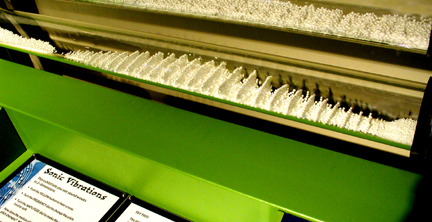Chapter One: An Acoustics Primer

13. What are standing waves?
A particular pattern of constructive and destructive interference is called a standing wave, which is essential to the way most musical instruments produce sound, but very undesirable in the listening environment of an electronic or recording studio.
The prior examination of constructive and destructive interference, along with concepts of reflected phase come into play. When two traveling sound waves are propagating in opposite directions, as a result of reflections inside a bounded system, be it a tube, string or room, the interference of these waves combine to create a resultant wave that appears to stand still at certain resonant frequencies called modes. These modes generally correspond with harmonic partials, with the first mode producing the fundamental. In a listening environment, these are called room modes, and the result is they unduly enhance or suppress certain frequencies at different spots in the room.
String Modes: The fundamental resonating frequency of a string is determined by its tension, mass and length (see formula). An ideal string* will produce the fundamental and all harmonic partials, each as a standing wave force that will be combined with the others to produce the complex fluid shape and motion of the string (for a fascinating view of a bowed violin string demonstrating the modified Helmholtz "kink wave" motion, view this video).
First Six String Modes
Simulation created with free Falstad applets at www.falstad.com. Try them!Nodes and antinodes on the resultant vibrating string correspond to points of minimum (node) and maximum (antinode) displacement of the string, as illustrated in the video example below. String modes always have the mode + 1 number of nodes, and the mode number of antinodes. So a string vibrating in the fundamental mode has a node at each fixed end point, and one antinode in the middle, the point of maximum displacement. The second mode (2nd partial) has three nodes and two antinodes, and so forth. As you will note from the video below, the non-end nodes of the partials divide the string up into segments which are the inverse of the partial number, so the 2nd partial node is at 1/2 the string length, the 3rd partial nodes divide at 1/3 and 2/3, etc.. The location of the first node on either end of a string will also produce that partial as a harmonic if the string is touched lightly at those spots.
String Standing Wave Example
Simulation created with free Falstad applets at www.falstad.com. Try them!The video above demonstrates the 7th mode of vibration for a string bound on both ends. Note the 8 nodes and 7 antinodes. Because a bound string reflects 180° out of phase at its boundaries, play and pause the video to see the effect as well as the result created by the constructive and destructive interference of the two oppositely-traveling waves underneath.
*An ideal string has the optimal balance of mass, length and tension to produce perfect harmonic partials, even when struck or plucked. However, many strings, particularly on guitars and piano are not ideal and produce slightly inharmonic partials. Windings on lower strings attempt to increase mass to mitigate some of the non-ideal characteristics.
Standing Waves in Wind Instruments:
Woodwind instruments are examples of half- or quarter-wave resonators that produce multiple standing wave modes. The differences are whether the tube is open at both ends (flute, including the embouchure hole) or closed at one end, such as the oboe or clarinet—or cylindrical or conical. As discussed in the prior pages, air columns at boundaries reflect differently from string reflections (for air, at a closed end, there is no phase change, at an open end there is a 180° change). In the case of air columns, pressure nodes and antinodes refer to the minimal (node) pressure change and maximum (antinode) pressure change (either above or below equilibrium) in the tube. At the closed end, where there is no phase shift, there is maximum pressure change from the constructive interference that occurs and we would call that a pressure antinode. That is the location that maximum compression or rarification takes place. At an open end (for example, an oboe), the 180° flip creates a pressure node of minimum pressure change due to the destructive interference, so a pressure node represents a location of equilibrium. A flute, which is considered open on both ends has pressure nodes on both ends. If you return to an earlier graphic, you will notice that pressure and displacement (how far an air molecule has been pushed off its origin) are in a cosine-sine relationship. Therefore displacement nodes and antinodes are in this same offset relationship. An air pressure node is an air displacement antinode and visa versa.
Pressure Nodes and Antinodes in Cylinder Open on One End
LEGEND: N = pressure node, A = pressure antinode, green = maximum compression, red = maximum rarefaction, black = equilibriumSimulation created with free Falstad applets at www.falstad.com. Try them!
[GRAPHIC OF AIR COLUMN STANDING MODES HERE, similar to these]
Standing Waves in a Fully Closed Tube:
We have not yet mentioned tubes which are closed on both ends. Below is a picture of a fully enclosed tube with a loudspeaker at one end (some examples use a pulled rosin-coated rod to excite the sound inside the tube). As certain resonant frequencies are played, the pellets in the tube form the nodes and antinodes of a standing wave pattern for that mode. Each end of the tube forms a pressure antinode, with the pellets visually responding to create the standing wave pressure nodes (flat spots) and antinodes (ridges) across the tube. This is an example of a Kundt's Tube experiment.

Exhibit built and designed by the WonderLab Exhibit Team led by Don Marvel, Bloomington, Indiana.